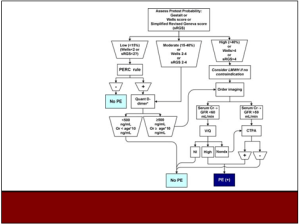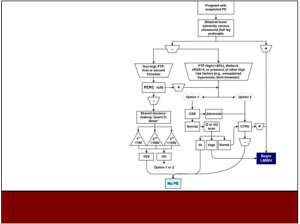Here’s an excerpt from our ED-Public Health website (http://www.edpublichealth.com):
ACEP’s contributions to the Choosing Wisely Campaign
At ACEP13 last October in Seattle, the organization announced its 5 contributions to the Choosing Wisely Campaign. Initially started by the American Board of Internal Medicine (ABIM) Foundation, the Choosing Wisely Campaign was a response to the movement towards improved healthcare efficiency and a need to decrease unnecessary/low-value procedures and tests. Despite ACEP’s original reluctance to join, in February 2013 ACEP jumped on board and began creating their list of recommendations. After extensive review by an expert panel of emergency physicians and the ACEP Board of Directors, ACEP’s Choosing Wisely recommendations were released.1,2 They include:
1. Avoid Head CTs in ED patients with minor head injury who are at low risk based on validated decision rules.
2. Avoid placing indwelling urinary catheters in the ED for either urine output monitoring in stable patients who can void, or for patient or staff convenience.
3. Don’t delay engaging available palliative and hospice care services in the ED for patients likely to benefit.
4. Avoid antibiotics and wound cultures in ED patients with uncomplicated skin and soft tissue abscesses after successful incision and drainage and with adequate medical follow-up.
5. Avoid instituting IV fluids before doing a trial of oral rehydration therapy in uncomplicated ED cases of mild or moderate dehydration in children.
You be the judge.
Here is a list of pros and cons formulated based on literature review, articles and editorials from other emergency physicians (EPs).
Pros:
1. Reduce cost without affecting quality of care.1,2
2. Improve efficiency.1,2 Example: shorter LOS if imaging is involved
3. Encourages shared decision-making between patients and physicians.1,2,8
4. Medical benefits: Less ionizing radiation exposure, less risk of antibiotic-resistant organisms, fewer catheter-associated UTIs.1,2,4
5. EP-generated, EP-approved. EPs are identifying “low value” procedures/tests for their own speciality, rather than letting others define these for us.1,2,6 For example: the proposed, but ultimately rejected, CMS “use of Brain CT in the ED for atraumatic headache” measure was created by CMS without EP input.8
Cons:
1. Lack of advocacy for medical liability reform.1,2,5
2. EPs have no right of refusal to our patients.5
3. EPs often pick up the slack for other doctors.5
4. Will it come to a point where these 5 tests/procedures will be uncompensated?5
5. Loss of autonomy.6
Other lists of over-used and “low value” tests exist out there. Most notable is a list of 5 tests which was created by EPs and mid-level providers from six Partners Healthcare hospitals near Boston. Published in JAMA, this list was designed to be “actions a specialty provider”7 can take.6,7 They include:
1. Do not order CT of the C-spine for patients after trauma who do not meet NEXUS low risk criteria or the Canadian C-spine Rule.
2. Do not order CT to diagnose PE without first risk stratifying for PE (pretest probability and D-dimer tests if low probability). (included in ACR’s Choosing Wisely list)3,4
3. Do not order MRI of the L-spine for patients with lower back pain without high-risk features. (included in AAFP’s and ACP’s Choosing Wisely list)3,4
4. Do not order CT of the Head for patients with mild traumatic head injury who do not meet New Orleans criteria and Canadian CT Head Rule.
5. Do not order coagulation studies on patients without hemorrhage or suspected coagulopathy (eg: with anticoagulation therapy, clinical coagulopathy)
ACR = American College of Radiology, AAFP = American Academy of Family Physicians, ACP = American College of Physicians
Bedside actions: to begin incorporating these EP-approved recommendations into our daily practice in an effort to institute cost-effective quality medical care (ideally before private insurers, CMS, or other specialty societies begin mandating us to do the same)
References:
1. ACEP Announces List of Tests as Part of Choosing Wisely Campaign. ACEP Clinical & Practice Management. October 14, 2013. Downloaded from http://www.acep.org/Clinical—Practice-Management/ACEP-Announces-List-of-Tests-As-Part-of-Choosing-Wisely-Campaign/.
2. ACEP Prepares List for Choosing Wisely Campaign. ACEP Clinical & Practice Management. Downloaded from http://www.acep.org/Clinical—Practice-Management/ACEP-Announces-List-of-Tests-As-Part-of-Choosing-Wisely-Campaign/.
3. Choosing Wisely Master List. www.choosingwisely.org. Downloaded from http://www.choosingwisely.org/wp-content/uploads/2013/02/Choosing-Wisely-Master-List.pdf.
4. Mahesh, M. and Durand, D.J. The Choosing Wisely Campaign and its Potential Impact on Diagnostic Radiation Burden. J Am Coll Radiol. 2013; 10(1): 65-6.
5. Seaberg, David. Pro/Con: Why ACEP Should Not Join the ‘Choosing Wisely’ Campaign. Emergency Physicians Monthly. Published August 24, 2012. Downloaded from http://www.epmonthly.com/features/current-features/the-wiser-choice-should-acep-join-the-choosing-wisely-campaign-no/.
6. Schuur, J.D., Carney, D.P., Lyn, E.T., Raja, A.S., Michael, J.A., Ross, N.G., and Venkatesh, A.K. A Top-Five List of Emergency Medicine: A pilot project to improve the value of emergency care. JAMA Intern Med. 2014; 174(4): 509-515.
7. The Tale of Two Lists: Procedures to Avoid in the ED. Acute Care, Inc. Published February 25, 2014. Downloaded from http://www.acutecare.com/the-tale-of-two-lists-procedures-to-avoid-in-the-ed.
8. Venkatesh, A.K. and Schuur, J.D. A “Top Five” list for emergency medicine: a policy and research agenda for stewardship to improve the value of emergency care. American Journal of Emergency Medicine. 31 (2013) 1520-1524.
![Room9er ["Room Niner"]:](https://room9er.com/wp-content/uploads/2020/03/cropped-Screen-Shot-2020-03-08-at-3.16.16-PM.png)

